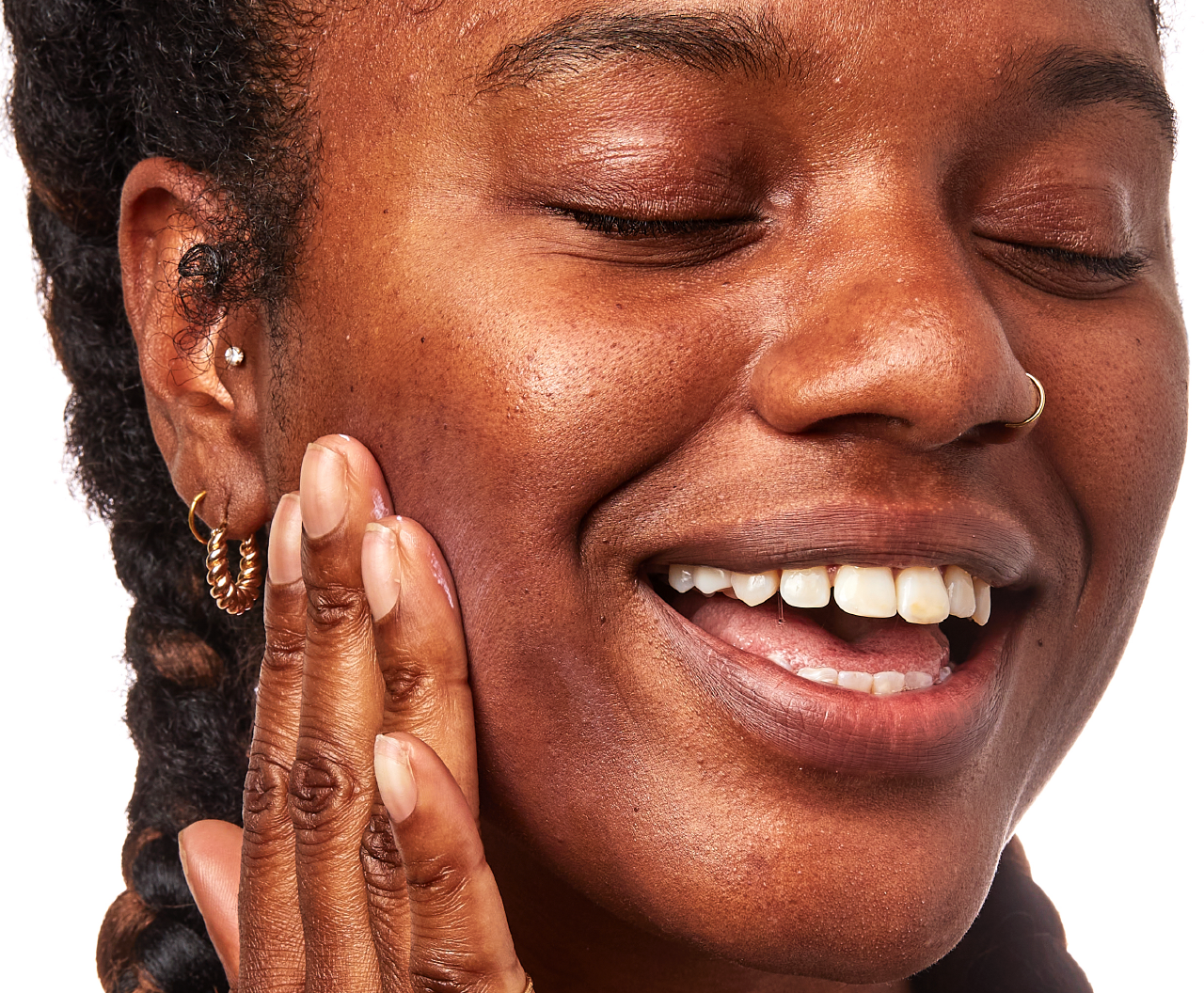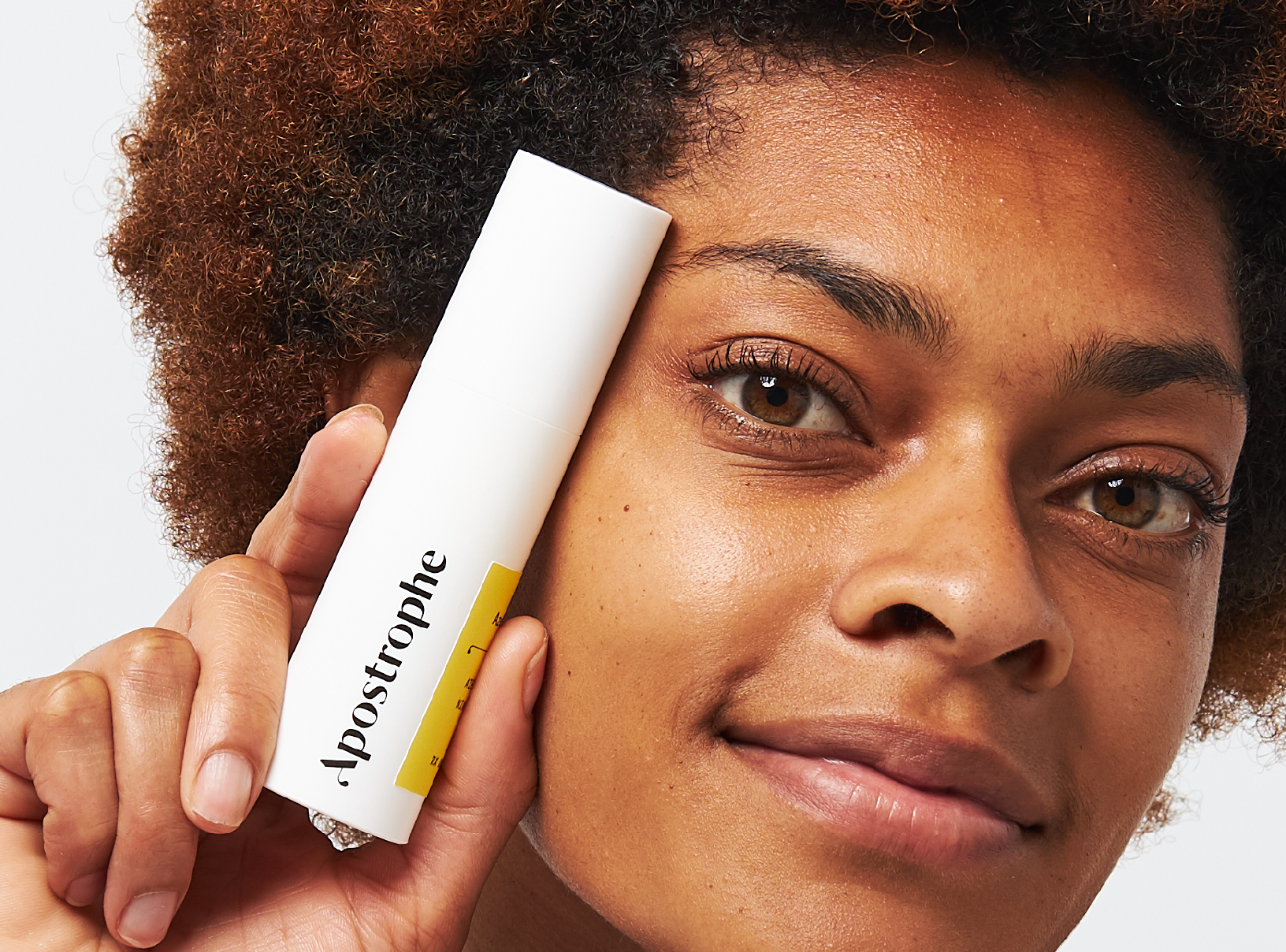Education
How to get rid of large pores on your face


SHARE
Education
How to get rid of large pores on your face
Medically reviewed by Kristin Hall, FNP
Written by Apostrophe Team
Last updated 10/1/2024
Your face gets noticed — it’s a fact of life. And whether it’s acne or wrinkles, any shift can feel like cause for concern or a sign that we need to change our skin care routine.
So what about enlarged pores? Should you be worried about them? Do they need to be treated?
Read on to learn more about pores — including what causes large pores on your face and how to minimize their appearance if you choose.
What Are Pores?
Interestingly enough, what we tend to think of as pores in our skin could be a misnomer. True pores are the sweat glands and sebaceous glands that serve to keep us cool and our skin moisturized, respectively.
They can’t be seen by the naked eye and need to be viewed under a microscope for visibility.
When we talk about facial pores, however, we’re actually talking about indentations in the skin that contain many of those aforementioned glands.
Think of it this way, a “pore” usually refers to a hole that secretes or intakes a substance, like when the glands in your skin secrete sweat or oil.
Any substance that you’ve had secreted from the indentations on your face, as you may notice with a pimple for instance, is being released from the many true pores within.
For simplicity, we’ll stick with the misnomer and use “pore” to refer to the holes we may notice on our faces when we look in the mirror.
What Causes Enlarged Pores?
According to the Dermatologic Surgery journal, the main causes of enlarged pores include:
Excessive sebum production, referring to oily skin caused by the natural production of sebum
Decreased skin elasticity, typically caused by sun damage or aging
Production of thick hair from the follicles
Other causes of larger pores include a history of chronic acne, skin care regimen, and sex hormones.
How to Reduce the Appearance of Large Pores
First things first, larger pore sizes are not a sign of unhealthy skin. Therefore, seeking treatment is an entirely personal choice.
Some individuals with large pores on their faces may dislike the appearances of them and decide to explore options for reducing their visibility, while others may decide to let them be. Both choices are entirely valid.
The treatments for enlarged pores are targeted at treating the cause of the pore appearing larger, like reducing sebum production. Let’s jump into the options available to you.
Apply Topical Retinoids
Retinoids are a class of medication derived from vitamin A and are useful for a variety of skin concerns from reducing the effects of aging to minimizing the appearance of stretch marks.
For the purpose of addressing enlarged pores, retinoids are great for people whose pores appear larger due to acne, oily skin, or a lack of firmness in the skin. They work by increasing collagen production and cell turnover.
Retinoids come in a variety of strengths, including as a prescription in the form of tretinoin.

PRESCRIPTION TRETINOIN
Target acne, dark spots, and signs of aging with this science-backed ingredient.
Tretinoin is an ingredient that could be in your Apostrophe topical treatment, which is available following a consultation with a healthcare provider who will determine if a prescription is appropriate.
Use Sun Protection
As a preventative method for discouraging pores from enlarging due to sun damage, you should wear a water-resistant, broad-spectrum sunscreen with 30 SPF or more to support your skin health.
The effects of sun exposure appear over time on all skin types, so it is never too early to start protecting your skin from the effects of photodamage.
Stick to Non-Comedogenic Products
Clogged pores can lead to your pores appearing larger, so you’ll want to be sure to select non-comedogenic skin care products, which contain ingredients that won’t clog your pores.
It is also good to look for products that are oil-free so that you don’t pile on top of the oil naturally produced by your skin.
Cleanse Your Face Twice Daily
Face washing can help prevent two of the main causes of highly visible pores: oily skin and clogged pores. It’s also great for washing off the grime from the day and ensuring your skin is makeup-free when you head to bed for the night.
You’ll want to wash your face with a gentle, non-comedogenic cleanser and warm water. The goal is to keep your skin as calm as possible, since pores can appear larger on irritated skin.
Treat Aging Skin
Sagging skin can lead to more visible pores, so you may want to consult with your healthcare provider to learn about skin tightening procedures.
Laser treatments, ultrasound therapy, and radiofrequency therapy are some examples of outpatient procedures that will help increase collagen production in your skin and tighten its appearance.
To be proactive about delaying the effects of aging, anti-aging products can also be a good choice.
Exfoliate Your Skin
Chemical peels like salicylic acid may be a good choice for helping to clear away dead skin cells, with the added benefit of reducing sebum production.
You’ll find salicylic acid to be a common ingredient in acne treatment products, making it a good choice if your enlarged pores are a result of acne or oily skin.
Addressing Large Pores on Your Face
The treatment of enlarged pores is up to you, but you’ll want to consult with a healthcare professional to help determine what might be causing your pores to appear larger. You can then decide on an appropriate treatment.
It’s helpful to use products designed to work together to avoid potential irritation. (For example, you won’t want to double up on peels.)
It’s also a good idea to try products customized for your skin’s needs.
Overall, keeping your skin clean and protected from the sun will be a great start to helping your skin look its best now and in the future.
References:
Flament, F., Francois, G., Qiu, H., Ye, C., Hanaya, T., Batisse, D., Cointereau-Chardon, S., Seixas, M. D., Dal Belo, S. E., & Bazin, R. (2015). Facial skin pores: a multiethnic study. Clinical, cosmetic and investigational dermatology, 8, 85–93. Retrieved from https://www.ncbi.nlm.nih.gov/pmc/articles/PMC4337418/
Lee, Sang Ju MD, PhD; Seok, Joon MD; Jeong, Se Yeong MD; Park, Kui Young MD, PhD; Li, Kapsok MD, PhD; Seo, Seong Jun MD, PhD Facial Pores, Dermatologic Surgery: March 2016 - Volume 42 - Issue 3 - p 277-285. Retrieved from https://journals.lww.com/dermatologicsurgery/Abstract/2016/03000/Facial_Pores__Definition,_Causes,_and_Treatment.1.aspx
Dong, J., Lanoue, J., Goldenberg, G. (2016, July). Enlarged Facial Pores: An Update on Treatments. MDedge. Cutis. 98(1):33-36. Retrieved from https://www.mdedge.com/dermatology/article/110032/acne/enlarged-facial-pores-update-treatments
American Academy of Dermatology Association. (2021, May 25). Retinoid or retinol. Retrieved from https://www.aad.org/public/everyday-care/skin-care-secrets/anti-aging/retinoid-retinol
What can treat large facial pores? American Academy of Dermatology Association. Retrieved from https://www.aad.org/public/everyday-care/skin-care-secrets/face/treat-large-pores
Do retinoids really reduce wrinkles? (2019, October 22). Harvard Health Publishing. Retrieved from https://www.health.harvard.edu/staying-healthy/do-retinoids-really-reduce-wrinkles
Many ways to firm sagging skin. American Academy of Dermatology Association. Retrieved from https://www.aad.org/public/cosmetic/younger-looking/firm-sagging-skin
Kornhauser, A., Coelho, S. G., & Hearing, V. J. (2010, November 24). Applications of hydroxy acids: classification, mechanisms, and photoactivity. Clinical, Cosmetic and Investigational Dermatology, 3, 135-142. Retrieved from https://www.dovepress.com/getfile.php?fileID=8202
Like what you just read? Sign up for our email list to get the scoop on skincare science delivered straight to your inbox.

Deep Dives
A dermatologist shares his thoughts on the recent studies about benzoyl peroxide and benzene.
Read More
Education
What is milia?
What is milia? Today, we’re jumping into one type of bump that you may have heard about most commonly in infants — milia.
Read More
Education
Best moisturizer for acne-prone skin
If you have combination acne-prone skin, figuring out which moisturizer is best for your skin might be tough. In this guide, we break down the best moisturizer for combination, acne-prone skin.
Read More
